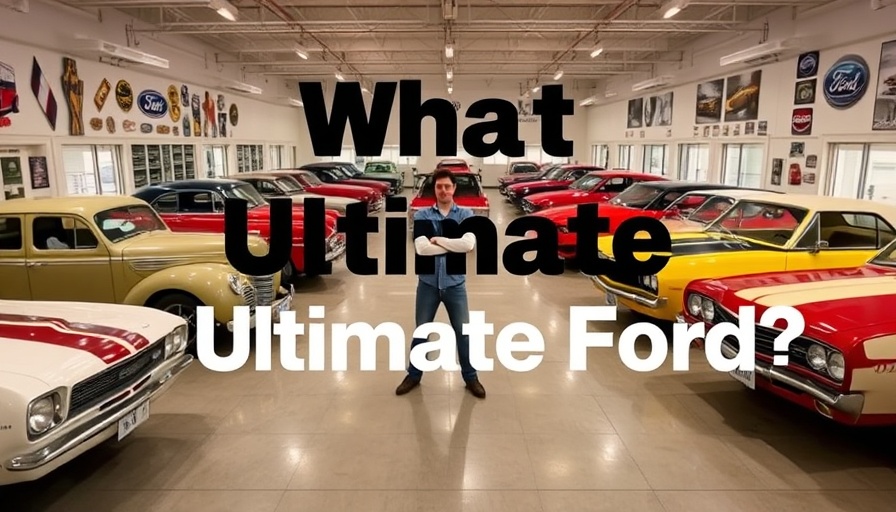
The Drive Behind Iconic American Cars
In a recent episode of Jay Leno's Garage, the spotlight is on Dave Pericak, the mastermind behind some of Ford's most iconic vehicles, including the Mustang, GT, and Bronco. With a career steeped in automotive innovation and performance, Pericak shares his journey—highlighting the passion and engineering prowess that drive Ford's legendary reputation in the automotive world. His insights not only reflect the values of the Ford brand but also underscore the commitment to creating vehicles that capture the hearts of car enthusiasts everywhere.
In 'Ford’s Performance Boss Behind Mustang, GT & Bronco Dave Pericak Joins Jay Leno!', the conversation dives into the world of automotive innovation and maintenance, exploring key insights that sparked deeper analysis on our end.
The Enduring Appeal of American Muscle
With the Mustang at the core of Ford's identity, Pericak emphasizes the importance of maintaining its classic allure while embracing modern advancements. The Mustang isn't just a car; it symbolizes freedom and power, resonating deeply with American culture. As consumer preferences shift toward electric and hybrid vehicles, maintaining this connection with customers becomes crucial. Ford’s challenge is to incorporate cutting-edge technology without sacrificing the raw adrenaline of performance that defines muscle cars.
Craftsmanship and Legacy: A Peek Under the Hood
During their conversation, Pericak reflects on the engineering and design processes involved in creating the GT and Bronco. Each vehicle is an embodiment of years of research and development, allowing them to balance performance with safety and comfort. As a result, the Bronco has evolved into a versatile SUV, designed not only for adventure but also for family use, highlighting the duality of functionality and fun that modern drivers seek.
Understanding the Importance of Vehicle Maintenance
As knowledgeable as Pericak is about performance vehicles, he also stresses the importance of vehicle maintenance. Regular maintenance ensures longevity and reliability, and any car owner should understand a basic car maintenance checklist. This includes checking fluids like engine oil, coolant, and brake fluid regularly, performing tire rotations, and paying attention to the condition of belts and hoses. Understanding these aspects can significantly improve vehicle performance and extend its life, paralleling the care that goes into creating these high-performance machines.
Practical Car Maintenance Tips for Every Driver
For those looking to keep their vehicles in top shape, Pericak’s insights serve as a reminder of the simple yet effective car care tips that every driver should incorporate into their routine. A thorough oil change helps keep your engine running smoothly, and learning how to check car fluids ensures that your vehicle operates safely. In addition, understanding how to change an air filter and performing coolant system maintenance can boost fuel efficiency and enhance overall performance.
Gear Up for Seasonal Checkups
As seasons change, so should your automotive routine. Following a seasonal car maintenance checklist can help prevent issues down the road. For instance, inspecting your brakes as winter approaches could make a significant difference in safety on icy roads. Moreover, knowing when to check and replace tires enhances not just performance but also ensures your safety and efficiency.
Future Trends in Vehicle Maintenance and Driver Education
Looking ahead, as automotive technology continues to evolve, the methods for vehicle maintenance will also change. Innovations such as predictive analytics and AI-based diagnostics could enhance how drivers approach maintenance. The rise of best car maintenance apps allows users to track service schedules and inputs in real-time, creating a more proactive rather than reactive approach to car care.
Understanding the Emotional Connection
For many, vehicles are more than a mode of transportation; they evoke memories and symbolize freedom. This emotional connection to automobiles is something that Pericak acknowledges and respects in his work. Car enthusiasts appreciate the craftsmanship, performance, and history that accompany American brands, making it essential for manufacturers like Ford to nurture these connections through quality and innovation.
Through Leno’s engaging interviews, viewers not only gain a deeper understanding of the vehicles but also the diligent work behind them. Pericak's passion is infectious, reminding us that the heart of any vehicle isn't just its engine or design but the stories and experiences that come with it. Whether you're thinking about car maintenance tips for your vehicle or simply admiring the engineering behind legendary models, the conversation serves as a potent reminder of the importance of understanding and caring for what we drive.
Each chapter in car maintenance and performance adds to the broader narrative of automotive culture, illustrating how tightly our vehicles are woven into our lives. As we reflect on the innovations and future of this industry, let's remain committed to ensuring that both classic and modern cars receive the attention they deserve—because in the end, every road trip begins with the care we give our vehicles.
 Add Row
Add Row  Add
Add 




Write A Comment